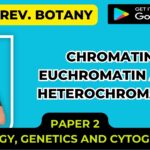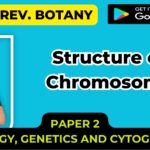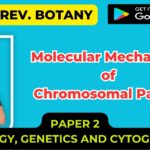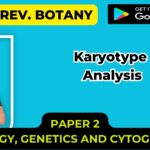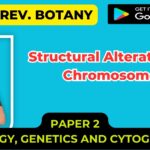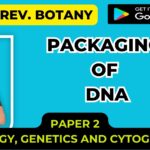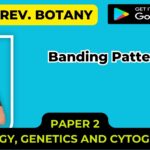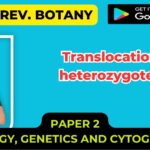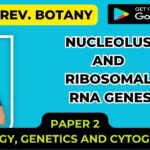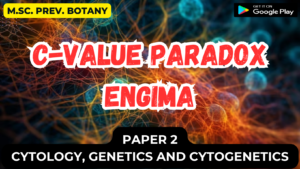![]()
Specialized Type of Chromosome
- The preceding section in this chapter dealing with chromosomes in eukaryotes was devoted to structure and function of chromosomes as observed in mitotic or meiotic cells in plants and animals.
- In certain organisms there are special tissues where these chromosomes take up a special structure.
- Lamp brush chromosomes of the vertebrate oocyte and giant chromosomes of salivary gland cells of dipterans are such special types of chromosomes.
- Due to special significance of these chromosomes, a relatively detailed account of these types of chromosomes will be presented.
A Chromosome –
- Normal Chromosomes are called A Chromosome.
B-chromosomes
- B-chromosomes are a particular kind of supernumerary chromosomes that may or may not be found in an organism as extra chromosomes over and above the standard diploid or polyploidy chromosome complement.
- The standard complement consists of chromosomes described as A-chromosomes, including sex chromosomes, if any.
- The B-chromosomes are found in the natural populations of many plant and animal species and are recognized on the basis of their following characteristics:
- 1) They are dispensable (they are not found in all individuals of a species and may not be found in all cells of an individual organism)
- 2) They are not homologous with any of the basic A-chromosomes.
- 3) Their inheritance is non-Mendelian, sometimes due to non-disjunction during pollen mitosis (as in some plants)
- 4) They are usually smaller than A-chromosomes and have their own unique pattern of heterochromatin distribution
- 5) In general inert, but may rarely organize nucleoli and carry functional genetic material
- 6) When present in high number, they suppress vigour and fertility
- 7) Their origin and function are largely unknown.
- B-chromosome in plants has been reported in more than 1000 species distributed over bryophytes (including mosses), ferns, gymnosperms and angiosperms (both monocotyledons and dicotyledons). Mostly, they are found in out-breeders (cross pollinated species).
- In the family Gramineae, they are found in 200 species including cereals and forage grasses belonging to genera Agrostis, Anthoxanthum, Avena Bromus, Calamogrostis, Dactylis, Deschampsia, Festuca, Koeleria, Lolium, Pennisetum, Phleum, Secale, Sorghum and Zea.
- These B-chromosomes are often absent in well adapted agronomic strains, and are perhaps eliminated due to selection.
- The B-chromosomes may sometimes be restricted only to aerial parts (absent in roots e.g. Aegilops speltoidas, Ae. mutica) and may also be eliminated during meiosis due to their division at anaphase I followed by elimination at anaphase II.
- B chromosomes may also increase in number due to a drive involving non-disjunction during pollen mitosis, thus leading to the production of plants with an increased number of B-chromosomes in the progeny of a cross 0B ♀ x 1B ♂.
- The most significant effect of B-chromosomes is on seed and pollen fertility.
- Flowering time is generally delayed by B-chromosomes and several characters (plant height, plant weight and tiller number) are adversely affected.
- A very important effect of B-chromosomes relates with their effect on pairing of A chromosomes in
- i) plants carrying these B-chromosomes and in
- ii) species hybrids involving a parent carrying B-chromosomes.
- In rye, although 0-6 B chromosomes did not influence the chaismata frequencies, 8 B chromosomes drastically influenced the range of chaisma frequencies among pollen mother cells (PMCs) and among bivalents within individual PMCs.
- In maize, the use of various A/B interchange stocks demonstrated that the genetic elements affecting meiotic pairing of A-chromosomes appeared to be widely distributed throughout the length of B-chromosomes.
- The effect of B-chromosomes in suppressing or promoting meiotic pairing has been shown in a number of intergeneric or interspecific hybrids (wheat x Aegilops sp.; wheat x rye, Lolium x Festuca; interspecific hybrids within the genus Lolium, etc).
3-M- Chromosome
- They are also called microchromosomes.
- They are 0. 5µ in size.
- It is formed during meiosis.
- They are found in 2-5 numbers.
- sphagnum (Brayophyts) has two microchromosomes.
4- Mega chromosome
- They are many times larger than the normal chromosome.
- They are also called Gaint Chromosome.
- It is only one present in a cell.
- It is 15 times larger than the normal chromosome in tobacco.
Lampbrush chromosomes

- It was discovered by Rukert in 1892
- It is found in the oocytes of vertebrates.
- These occur in Diplotene stage of Meiosis division 1
- At the time of division, they increase in length, which is creating a specific loop so it is called the lampbrush chromosome.
- The lampbrush chromosomes are characterized by a remarkable change in structure.
- The change in structure includes an enormous increase in length.
- These chromosomes must sometimes become even larger than polynemic giant salivary gland chromosomes.
- The largest chromosome having a length upto 1mm has been observed in urodele amphibians.
- The chromosomes seem to have a chromomeric pattern with loops projecting in pairs from majority of chromomeres.
- One to nine loops may arise from a single chromomere.
- The size of loops varies with an average of 9.5μ in inter-chromomeric fibres.
- The pairs of loops in these chromosomes give them the characteristic lampbrush appearance.
- They consist Loop of both the lateral side of the main axis and the axis is covered by a matrix made of RNA and protein.
- mRNA is produced by the DNA present on the lateral loop. This mRNA synthesize protein for yolk formation.
- Apart from this, tRNA and rRNA are also found.
- Once Yolk is synthesized, it shrinks.
- Loop is made up of chromosomes.
- 1-9. Loops are made from a chromosome
- until the meta-phase their number decreases and they disappear.
- H. Ris, however, had thought that the loops were integral parts of chromonemata which are extended in the form of major coils.
- It is also believed that the loops represent the modified chromosome structures at the loci of active genes.
- It has been observed that, if the activity of these genes is stopped by actinomycin D (actinomycin D stops synthesis of RNA and DNA templates), the loops will collapse, suggesting that the loops mainly consist of RNA.
Salivary gland chromosomes
- They were discovered by Balbiyani in 1881
- It is found in salivary glands, Malpighian tubules, epithelium cells of the intestines of insects and fat bodies found in the larval stage.
- They are many times larger than normal chromosomes.
- They are formed by diploid division of chromosomes 9–10 times.
- They do not separate after splitting and remain connected like threads.
- When staining with fulgen dye, it exhibits lighter and darker bands.
- The light band has less DNA, while the dark band has higher DNA content.
- These bands have greatly helped in the mapping of chromosomes in cytogenetic studies.
- The bands occasionally form reversible puffs, known as chromosome puffs or Balbiani rings, which are associated with differential gene activation.
- The giant chromosomes represent each a bundle of fibrils which arise by repeated cycles of endo-reduplication of single chromatids.
- Endo-reduplication means that the chromatin replicates without cell division, as a result of which the number of chromonemata keeps on increasing.
- This is why these chromosomes are also popularly known as polytene chromosomes and the condition is described as polyteny.
- The number of chromonemata (fibrils) per chromosome may reach upto 2000 in extreme cases.
- Some workers placed this figure as high as 16,000.
- It has Five long and one short strand mass known as chromocenter.
- One long strand corresponds to the X chromosome and the remaining four long strands are the arms of II and III & IV chromosomes.
- The centromeres of all these chromosomes fuse to form the chromocenter.
- In the male flies the Y chromosome is also found fused within the chromocenter and is therefore not seen as a separate strand.
- They are sized up to ~ 200 µ

Fig. Salivary gland chromosome from nucleus of female Drosophila

Fig. Balbiani rings
Sex chromosomes
- Sex chromosomes are those chromosomes whose presence, absence or particular form determines the sex of the individuals in unisexual or dioecious organisms e.g., XX-XY, XX-XO, ZZ-ZW, ZZ-ZO etc.
- Sex chromosomes are also called idiochromosomes or allosomes.
- Besides determining sex, these chromosomes also controls a number of morphophysiological traits called sex linked character.
- Chromosomes other than sex chromosomes are known as autosomes and determine morphophysiological characters of the organism which are similar in both the sexes and are not not sex linked.
- The two sex chromosomes in an individual may be morphologically similar that is homomorphic (e.g., XX) or different that is heteromorphic (e.g., XY).
- The morphologically different is androsome (Y chromosome or male determining in some organism) and gynosome or female determining in others (e.g., W).

